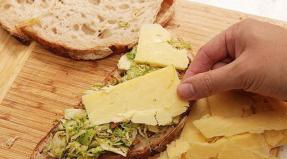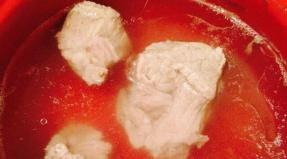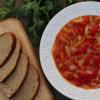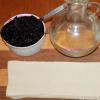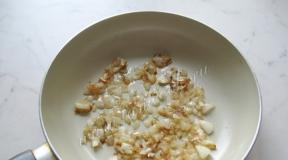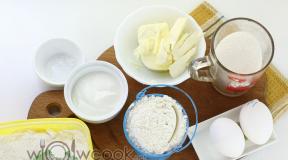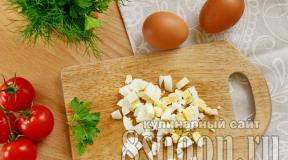Why is cheddar orange. Cheddar cheese - a symbol of England
Cheddar- This is perhaps the most famous of the English cheeses. It is a classic hard cheese made from pasteurized cow's milk with a dense, crumbly texture and a pale yellow dough color. Some farmers tint Cheddar with natural annatto dye to create a Cheddar red (deep orange). The taste of cheddar is creamy, spicy with a slight acidity and a pleasant nutty aftertaste. Like other hard cheeses, Cheddar can be consumed both on its own and as a component and a highlight in various dishes (pizza, soups, sandwiches, julienne, etc.). Interestingly, the inhabitants of the United Kingdom are very fond of the combination of Cheddar with mustard, or bananas, washed down with cider or weak wines. Cheddar cheese melts great. These qualities have made Cheddar the "universal soldier" in the kitchens of many housewives, as well as the best-selling cheese in the world. This type of cheese is not protected by region of origin, so now cheeses labeled with the name "Cheddar" can be produced not only in Somerset, England, but also around the world. It should be noted that at present, Cheddar is produced in the United States in huge quantities, and is supplied from there even to Great Britain, the homeland of this cheese.
History of Cheddar cheese is more than 800 years old and begins in the 12th century. It got its name, like many other varieties of cheese, from the name of the settlement in which it was first made, namely, the village of Cheddar in Somerset. The cheese, which later received worldwide fame, was ripened in the caves of the Cheddar gorge, not far from the village of the same name. The temperature and humidity conditions in these caves were ideal for the cheese ripening process. The first mention of the purchase of Cheddar cheese can be found in the records of the King of England, dated 1170 AD. (during the reign of Henry II). This type of cheese has always enjoyed special love and the disposition of the English monarchs, who ordered the purchase of tons of it for royal celebrations. During the reign of King Charles I (1625-1649), this cheese was bought up by the royal court at the production stage; it was simply impossible to meet, buy or taste it outside the palace walls. The works of Joseph Harding (19th century), who described and standardized the technology of production of Cheddar cheese in detail, brought its quality to a new level and ensured world fame and recognition for this cheese, and the author himself earned the honorary title of "Father of Cheddar".
The technology for the production of Cheddar cheese includes a special stage called cheddarization. This procedure is typical for the production of most English types of cheese and consists in cutting the cheese dough into layers and shifting them on top of each other over a long period of time. Cheddar allows the cheese dough to reach the correct acidity level (pH 5.6), and also provides it with a special density and consistency (cheddar layers get the texture of boiled chicken breast after cheddarization). Cheddar is produced in large heads weighing 25-35 kg.
Traditionally, Cheddar matures wrapped in a cloth (called a bandage). Ripening period can vary from 3 to 18 months:
- 3 months - young Cheddar
- 5-6 months - medium maturity
- 9 months - mature cheddar
- 15 months - extra
- from 18 months - vintage cheddar
The taste of Cheddar can also vary significantly and depends both on the place and characteristics of the production technology, and on the period and conditions of ripening. The most interesting and complex taste is possessed by cheeses aged from 9 months.
Cheese can be used as a snack, as is customary in our country, and for dessert, as is customary in many countries of the world. Any self-respecting country has given the world one or even several types of cheese. If we put the general principles of technology as a basis, then cheeses can be divided into the following main groups: hard, semi-hard, soft and fermented milk.
In each of these groups, in turn, the following types can be distinguished: hard cheeses include Swiss, Dutch, cheddar, Russian, pickled cheeses; to semi-hard - cheese like Latvian; to soft - cheeses of the types Dorogobuzhsky, Smolensky, Roquefort, Camembert and a number of others; fermented milk cheeses include tea, cream, etc.
CHEESE TYPE SWISS
In addition to the Swiss cheese itself, this group includes Soviet, Altai, Kuban, Carpathian, etc. All these cheeses have a peculiar delicate aroma, sweetish, spicy taste.
The international name for Swiss cheese is Emmental, after the alpine valley, which is considered the birthplace of this cheese. In the chronicles, Emmental cheese is mentioned for the first time in the 15th century.
Swiss cheese is produced in the form of a low wide cylinder up to 100 kg. Under proper conditions, it can be stored for up to 1.5-2 years. Maturation of Swiss cheese lasts 6-8 months, or even longer. It is distinguished by a delicate flavoring bouquet, which is dominated by a sweet-fresh, nutty flavor, a plastic oily consistency of the cheese mass and a well-defined pattern of rather large "eyes" with a "tear".
CHEESE TYPE DUTCH
Dutch cheese is available in the form of a round or bar. Dutch cheese contains at least 50% milk fat in dry matter and has less moisture (43%).
CHEDDER CHEESES
Cheddar is the most widespread cheese in many countries, especially in the USA, Canada, England. In these countries, 80-85% of the cheese produced is cheddar. This is primarily due to the fact that the production of cheddar lends itself to mechanization. It has the shape of a cylinder weighing 30-33 kg. It has a slightly sour, somewhat spicy taste. Its consistency is soft, delicate, oily, it can be smeared and crumbly.
This cheese dries quickly when cut, so it is cut just before use.
CHEESE RUSSIAN
Among many other cheeses, it stands out for its peculiar taste, inherent only in it. A delicate plastic consistency is combined with a pleasant, slightly sour taste, but the sourness has a different shade than, say, in Kostroma cheese, is more pronounced. Finally, it is less salty.
Latvian type cheeses
Semi-hard cheeses include Latvian-type cheeses, to which, in addition to the most Latvian, also include spicy, Volga, etc.
These cheeses are characterized by ripening with the formation of dried mucus on the crust. They have a rather strong (slightly ammoniacal) odor and a pungent taste.
The thin rind of these cheeses is covered with a small layer of special mucus. The pungency of their smell depends on its microflora, which is not a defect, but on the contrary, indicates sufficient maturity, endurance and good quality of the product. The ripening period for the cheese is 2 months.
It should be noted that spicy cheeses with a strong cheesy smell take some getting used to. Taste and habit for a new product are not created immediately, but gradually developed. In the beginning, maybe you won't like the product at all. However, having tried it several times, you begin to appreciate the originality of the product, and gradually it becomes one of your favorites. This applies to most soft cheeses.
ROQUEFORT
This is one of the more distinctive types of cheese. Among others, it stands out for the content of a large amount of green mold. Hobbyists believe that the more mold, the better the cheese.
The peculiarity of the Roquefort technology is that the culture of the Roquefort penicillium mold is introduced into the cheese mass, while the head of the cheese is pierced in many places with needles, because the mold develops well only when air is available. Mold gives a piquancy to cheese not only by itself, but also because it deeply breaks down fats, and decomposition products have a pungent taste. Mold gives the cheese not only a peculiar peppery taste and pungency, but also a tender texture.
Roquefort ripens in 1.5-2 months, salt in it is not more than 5%.
This cheese cannot be sliced very thinly. But thanks to its soft, oily consistency, it spreads well on bread, biscuits, dry table biscuits.
CHEESE AND CREAM
Tea cheese does not need to ripen. In appearance, it is a curd mass of unsharp lactic acid taste without foreign aftertastes. It contains about 55% moisture, the consistency of the cheese mass is tender, smearing, creamy.
The high nutritional value of these cheeses, especially in combination with juices and fruits, allows them to be recommended for children.
In our country, they make up the majority of the cheese produced. By size and weight, they are divided into large and small. According to the production technology and characteristic taste and smell - into the following types: cheeses of the Swiss type, Holland type, Cheddar type, Russian type, Latvian type.
CHEESES OF SWISS TYPE. For the production of these cheeses, high quality milk is used in terms of organoleptic properties, bacterial contamination and acidity.
SWISS CHEESE ripens for 6 months or more. In appearance it is a large low cylinder weighing 50-100 kg. On a strong and wrinkle-free crust there are prints of fabric - serpyanka, with which the cheese was pressed. A strong dry coating of a grayish-white color is allowed, the taste is sweetish, pleasant, with a well-pronounced taste and aroma. The eyes are round or oval, 50% fat.
SOVIET CHEESE is obtained from pasteurized milk. It has the shape of a rectangular bar with slightly cut vertical edges and convex side surfaces. Weight - up to 16 kg. Ripening period - 4 months, but the best taste when ripening 6-8 months. The taste is close to Swiss. Fat content 50%.
MOSCOW CHEESE is a kind of Soviet cheese, it differs in shape - a tall cylinder weighing 6-8 kg. Sweet and sour taste, fat content - 50%.
CARPATHIAN CHEESE has the shape of a low cylinder. Weight up to 15 kg. Ripens within 2 months. The taste is sweetish sour.
CUBAN CHEESE represents cheeses of a uniform cylindrical shape. In taste, aroma and consistency it is close to the Soviet one. Weight - up to 10 kg.
CHEESE TYPE DUTCH. Cheese of this type represent a wide range of pressed cheeses with a low second heating temperature.
DUTCH CHEESE. When using the low temperature of the second heating, more whey remains in the curd. This contributes to the more rapid development of lactic acid streptococci and faster maturation of cheese (up to 3 months). As a result, small eyes of a round, slightly flattened shape are formed. The texture of the cheese is elastic, softer than that of Swiss cheese. The shape of the cheese is round, weighing 2-2.5 kg, midget 0.4-0.5 kg; large squared 5-6 kg and small squared 1.5-2.0 kg. Ripe cheese is considered ripening, 2-2.5 months, midget - 35 days. When ripe up to 6-8 months, its taste becomes sharper and more pronounced. A sign of good quality is the appearance of a tear in the cheese. Dutch cheese is distinguished by its fat content: squared cheese - 45%, round - 50%. The taste and aroma are clean, with the presence of pungency and sourness, without foreign tastes and odors.
KOSTROMSKAYA cheese has the shape of a low cylinder with a convex lateral surface and rounded edges, weighing 9-12 kg (large) and 5-6 kg - small. In terms of technology and organoleptic characteristics, it is close to the Dutch one, ripens in 2.5 months.
YAROSLAVSKY CHEESE is produced in the form of a tall cylinder weighing 2-3 kg, a unified large cylinder weighing 8-10 kg and a unified small cylinder weighing 4-6 kg. Physicochemical and organoleptic characteristics are close to the Dutch bar. Fat content 45-50%.
STEPPE cheese is produced in the form of a bar with a square base, weighing 5-6 kg. The taste is spicy, the dough is slightly brittle. Fat content -45%. The surface of the bar is waxed.
COAL CHEESE has the shape of a rectangular bar weighing 2-3 kg. The cheese dough is tender, elastic, slightly brittle with round oval or irregularly shaped eyes. The taste is slightly sour. The cheese ripens within 2 months. The fat content is 45%.
POSHEKHONSKY CHEESE has the shape of a low cylinder weighing 5-6 kg. The eyes are round or slightly flattened. Fat content 45%. Duration of ripening is 1.5 months.
ESTONIAN CHEESE. Differs in accelerated ripening. It can be produced with a ripening period of 30 days. It has the shape of a tall cylinder, weighing 2-3 kg. Slightly sour taste, spicy aftertaste is allowed. The dough is tender, plastic. The eyes are round, slightly oval, evenly spaced. Fat content 45%.
DNESTROVSKY CHEESE - ripening quickly. Has the shape of a bar. The dough is tender, slightly smearing. Fat content 50%. ,
LITHUANIAN CHEESE. The shape of a rectangular bar, weight 5-6 kg. The taste is delicate and sour. The fat content is 30%.
CHEDDER CHEESES
A characteristic feature of the production of this group of cheeses is that the cheese mass is subjected to cheddarisation (fermentation) before molding. As a result, the development of lactic acid fermentation intensifies and lactic acid accumulates, which, acting on the protein, makes the mass soft, viscous, stratifies into thin, sheet-like layers. In this case, gas formation occurs, as a result of which eyes of irregular shape are formed. At the end of maturation, before molding, gassing subsides and the eyes collapse.
CHEDDER has the shape of a tall cylinder with a steep side surface and flat bases. Its weight is 30-33 kg. The maturity of the cheese is reached at the age of three months. The cheese has a soft shell that is tightly pressed into the dough. The surface of the cheese is waxed. Slightly sour taste and smell. The dough is plastic, tender, slightly smeared. Eyes are absent, fat content is not less than 50%. A type of Cheddar cheese is Gorny Altai cheese.
CHEESE TYPE RUSSIAN
It is made without chedcerization, but the curd after the second heating is kept at a temperature of 41-42 ° C for 4-50 minutes, while the acidity increases. Russian cheese is usually salted in grain, followed by salting the head in brine. Sometimes they use full salting in grain, without using salting in brine. The cheese has the shape of a low cylinder weighing 11-13 kg (large) and 7-9 kg (small). The taste and smell are slightly sour, pronounced; the dough is tender, plastic; eyes of irregular slit shape. The cheese has an even thin crust, the surface is covered with paraffin. Ripening period 70 days. The fat content is 50%.
CHEESE TYPE LATVIAN are semi-hard self-pressing cheeses with a low second heating temperature. Lactic acid and mucus-forming bacteria, which develop on the surface, are involved in the ripening of cheese. Ripening of cheeses goes from the surface to the center. The cheeses are characterized by spicy specific slightly ammonia taste and smell and high moisture content. Latvian cheese has the shape of a bar with a square base and convex side surfaces, weighing 2.2-2.5 kg. The crust is thin, covered with a slightly sticky thin mucus of a red-brown color with light specks. The dough is plastic. The eyes are oval irregular. The fat content is 45%.
SPICY CHEESE has the shape of a rectangular bar weighing 2-4 kg. The consistency is more delicate, as it has a fat content of at least 55%. Ripens 35-45 days.
Cheddar- This is perhaps the most famous of the English cheeses. It is a classic hard cheese made from pasteurized cow's milk with a dense, crumbly texture and a pale yellow dough color. Some farmers tint Cheddar with natural annatto dye to create a Cheddar red (deep orange). The taste of cheddar is creamy, spicy with a slight acidity and a pleasant nutty aftertaste. Like other hard cheeses, Cheddar can be consumed both on its own and as a component and a highlight in various dishes (pizza, soups, sandwiches, julienne, etc.). Interestingly, the inhabitants of the United Kingdom are very fond of the combination of Cheddar with mustard, or bananas, washed down with cider or weak wines. Cheddar cheese melts great. These qualities have made Cheddar the "universal soldier" in the kitchens of many housewives, as well as the best-selling cheese in the world. This type of cheese is not protected by region of origin, so now cheeses labeled with the name "Cheddar" can be produced not only in Somerset, England, but also around the world. It should be noted that at present, Cheddar is produced in the United States in huge quantities, and is supplied from there even to Great Britain, the homeland of this cheese.
History of Cheddar cheese is more than 800 years old and begins in the 12th century. It got its name, like many other varieties of cheese, from the name of the settlement in which it was first made, namely, the village of Cheddar in Somerset. The cheese, which later received worldwide fame, was ripened in the caves of the Cheddar gorge, not far from the village of the same name. The temperature and humidity conditions in these caves were ideal for the cheese ripening process. The first mention of the purchase of Cheddar cheese can be found in the records of the King of England, dated 1170 AD. (during the reign of Henry II). This type of cheese has always enjoyed special love and the disposition of the English monarchs, who ordered the purchase of tons of it for royal celebrations. During the reign of King Charles I (1625-1649), this cheese was bought up by the royal court at the production stage; it was simply impossible to meet, buy or taste it outside the palace walls. The works of Joseph Harding (19th century), who described and standardized the technology of production of Cheddar cheese in detail, brought its quality to a new level and ensured world fame and recognition for this cheese, and the author himself earned the honorary title of "Father of Cheddar".
The technology for the production of Cheddar cheese includes a special stage called cheddarization. This procedure is typical for the production of most English types of cheese and consists in cutting the cheese dough into layers and shifting them on top of each other over a long period of time. Cheddar allows the cheese dough to reach the correct acidity level (pH 5.6), and also provides it with a special density and consistency (cheddar layers get the texture of boiled chicken breast after cheddarization). Cheddar is produced in large heads weighing 25-35 kg.
Traditionally, Cheddar matures wrapped in a cloth (called a bandage). Ripening period can vary from 3 to 18 months:
- 3 months - young Cheddar
- 5-6 months - medium maturity
- 9 months - mature cheddar
- 15 months - extra
- from 18 months - vintage cheddar
The taste of Cheddar can also vary significantly and depends both on the place and characteristics of the production technology, and on the period and conditions of ripening. The most interesting and complex taste is possessed by cheeses aged from 9 months.
Ask anyone, and he will confirm the validity of the famous phrase: "Cheese is a delight in taste." And if we are talking about a product called "cheddar", then this delight in taste is doubly. Piquant and spicy, with a distinctly nutty flavor, it captivated not only the British, who are considered the inventors of this wonderful delicacy. No, Cheddar cheese is also America's favorite delicacy. There it is in second place in terms of consumption, second only to mozzarella.
An excursion into history
For the first time this dairy product appeared in Somerset, located in the south-west of England. There is a small village called Cheddar. It was she who became the birthplace of the famous cheese, and also gave it its name. Mentions of him are found in the 12th century. Even then, King Henry II proclaimed this product the best cheese in the entire territory of the British Kingdom.
Appearance of Cheddar cheese
This variety has many unique properties among its cheese brethren. Cheddar cheese has a cylindrical, sometimes rectangular shape. The head height reaches 40 cm, and the standard weight ranges from 27 to 35 kg. But the history of making cheeses keeps an isolated case worthy of the Guinness Book of Records. For the wedding of Queen Victoria, they presented a head of the mentioned type of cheese weighing 500 kg! Cheddar cheese is made from whole cow's milk, its fat content is 45%. The color is most often deep yellow, and sometimes even orange, but it can also be creamy. The product in question owes its bright color to the dye, which is obtained from the seeds of the exotic achiote tree. When kept in a dry cellar (up to 2 years), it acquires a strip in the middle, reminiscent of dark marble in color. This cheese is already called the melodic phrase blue Chedder, that is, "blue Cheddar".

The top of the cheese is covered with an oily crust. For better storage, it can be sealed in black wax. However, the most commonly used packaging material is cloth. It allows the product to "breathe" and saves it from contamination.
Features of the production of English cheese
Processed Cheddar cheese is savory in taste and pleasant in appearance. Its production is based on the heat treatment of cottage cheese, which increases the level of lactic acid. The temperature at which the curd is cooked is at least 38 degrees. Therefore, according to the cooking technology, Cheddar cheese is closer to boiled Gruyere cheeses. This delicious delicacy is prepared both in industrial plants and by hand, in small farms in England. The ripening period for this type of cheese is from six months to 2 years. But factory products are distinguished by a whole kaleidoscope of taste nuances. Cheeses are spicy, soft, ripe, medium, and there is even a variety such as old or vintage. The packaging will tell you what kind of cheese is in front of you. You can also find information on flavors and flavors there.
The constituents

It is worth noting one more feature of the product in question - the composition. Cheddar cheese contains a huge amount of nutrients. These are almost all vitamins of group B, as well as PP, E, A. In addition, it contains beta-carotene and niacin. Cheese "Cheddar" can be called a pantry of micro- and macroelements: magnesium, phosphorus, calcium, sodium, manganese - all this is in its composition. It is also saturated with amino acids: isoleucine, lysine,
Many people wonder how nutritious Cheddar cheese is. Its calorie content is 380 kcal, so this delicacy cannot be called dietary. But it does not contribute to gaining excess weight either.
Properties
Perhaps no other cheese product has such a set of useful properties as this one. Let's briefly list the main ones:
- This type of cheese is low in lactose, so even those people who are allergic to other dairy products can eat it.
- Cheddar stimulates the synthesis of saliva, as a result of which the oral cavity is cleansed and the risk of tooth decay is reduced.
- There are practically no carbohydrates in it, therefore, despite the high calorie content, it does not provoke a set of extra pounds. People who constantly adhere to a diet have already appreciated this feature of the product.
- This cheese stimulates the activity of the brain and nervous system.
- On the other hand, it has a calming effect, promotes good sleep and relieves stress.
- And, of course, which is very beneficial for the health of teeth and bones.

Homemade Cheddar cheese
Despite the fact that the process of making cheese is quite long, it is not difficult to make it yourself.
To get 900 g of a delicious product, you will need:
- 8 liters of fresh milk;
- 2.5 ml which is pre-dissolved in half a glass of purified water;
- 1.25 ml of mesophilic culture;
- 30 ml of finely ground sea salt.
Cooking technology
The whole process includes 4 stages:
1. Cooking cheese
All ingredients must be added to milk heated to 35 degrees. Then leave the mixture for 1-2 hours to thicken. Cut the resulting product into pieces and heat to 38-39 degrees. As it heats up, the mass will decrease in volume. The whey must be drained, and the cheese mass must be stirred constantly to avoid the appearance of lumps.
2. Cheddar cheese
It is this process that gives the product its original taste and aroma. Its peculiarity lies in the fact that semi-finished soft cheese must be kept in a dry saucepan for 2 hours at a temperature of 38 degrees. At the same stage, salt is added to it, and the whole mass is mixed by hand.
3. Spin
A press is placed on the cheese. It is believed that the pressure should be increased gradually. At first, its indicator should be equal to 4.5 kg. The product is kept under this pressure for 15 minutes. Further, the weight increases to 18 kg, and the duration of the spin cycle - up to 12 hours. Final stage: pressure - 22.5 kg, duration - 24 hours.

4. Maturation
First, the cheese is dried on a regular cutting board. When it's ready, you will notice a protective crust. Then it is covered with paraffin, pre-cooling the cheese and wiping it with gauze dipped in vinegar. Usually 2 layers of paraffin are applied. After that, the head is sent to the refrigerator and kept for at least two months. After the specified period, the product is ready for use.
How and where is Cheddar cheese used?
The mentioned product is quite popular and versatile. It is used for making salty biscuits, hamburgers, canapes, salads, omelets. This cheese can be used to make a versatile sauce with an amazing taste. It will be a great addition to fish, meat, potatoes or regular toast.
In England, cheddar is usually consumed at the end of a meal, washed down with port or Bordeaux. Sometimes pieces of cheese are served with beer.
The people of Great Britain have their own traditions. They prefer to consume this cheese with mustard or bananas. Well, there is no dispute about tastes, as they say.
Note! In order for the Cheddar cheese to restore its taste and consistency, it is taken out of the refrigerator half an hour before lunch and cut into small pieces.

What can replace Cheddar cheese
In terms of its taste and useful properties, the German Chester cheese is the equivalent of the English Cheddar cheese. You won't find any special differences, even the names are a bit similar, right? But here's the catch! It is unlikely that anyone will go to Germany in search of an analogue. Therefore, if you needed to cook a dish with this type of cheese, but you do not have it available at the moment, feel free to replace it with gouda or maasdam. Another main condition is also suitable - it should have a bright and rich taste.
